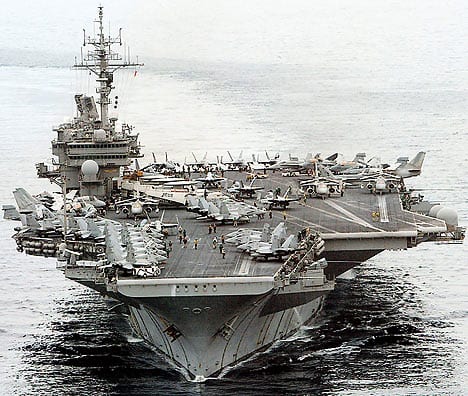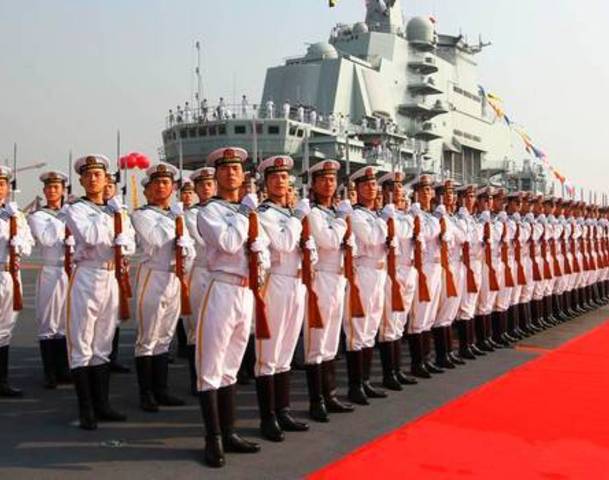Now hear this, now hear this…! This is NOT a joke…

The USS Kitty Hawk—like most US Navy carriers it is designed to project power, as an offensive weapon. They travel in battle group formations.
When kids play war, they end up spending less time shooting than arguing: “You’re dead!” “Am not! You missed!” It just gets worse the bigger the kids. I remember a D & D’er crying when his character got killed — wouldn’t talk to the rest of us for years, still grieving for his dead elf.

The War Nerd
By Gary Brecher
The (From the archives, originally published 11 December 2002)
The US military has been having exactly this kind of argument, played out in the world press, since last August. They’re even whinier and more of a pain about it than D&Ders, if you can believe that, with leaks and counter-leaks, planted stories, and plenty of good ol’ character assassination.
It all comes out of the “Millenium Challenge ’02” war games we staged in the Persian Gulf this summer. The big scandal was that the Opposing Force Commander, Gen. Paul van Riper, quit mid-game because the games were rigged for the US forces to win. The scenario was a US invasion of an unnamed Persian Gulf country (either Iraq or Iran). The US was testing a new hi-tech joint force doctrine, so naturally van Riper used every lo-tech trick he could think of to mess things up. When the Americans jammed his CCC network , he sent messages by motorbike.
[pullquote] Wherein satirist and serious war analyst Gary Brecher (a pseudonym) lays out the reasons why bullying a determined second-tier power like Iran might be a very bad idea for the US Navy, and why conventional armadas are now obsolete. Ironically, it is this reality—never discussed by the media— that may make the Joint Chiefs cautious when taking on adversaries with the requisite resources to strike back. Even low tech assets in the hands of a good tactical commander can quickly become deadly. However, there’s a Catch-22 in this new situation. The US is the kind of country that doesn’t accept a humiliating defeat. The implicit rule is: You mess with my conventional forces and I’ll probably go medieval on you. Nukes, anyone? [/pullquote]
But that was just playing around. They wouldn’t have minded that. Might’ve even congratulated van Ripen, bought him a drink for his smarts, at the post-games party.
The truth is that van Riperdid something so important that I still can’t believe the mainstream press hasn’t made anything of it. With nothing more than a few “small boats and aircraft,” van Riper managed to sink most of the US fleet in the Persian Gulf.
What this means is as simple and plain as a skull: every US Navy battle group, every one of those big fancy aircraft carriers we love, won’t last one single day in combat against a serious enemy.

The Navy brass tried to bluff it out, but they were pretty lame about it. They just declared the sunken ships “refloated” so the game could go on as planned. This is the kind of word-game that makes the military look so damn dumb. Too bad Bonaparte never thought of that after Trafalgar: “My vleete, she is now reflotte!” Too bad Phillip didn’t demand a refloat after the Armada went down: “Oye, vatos, dees English sink todos mi ships, chinga sus madres, so escuche: el fleet es ahora refloated, OK?”
Everybody in this story has an agenda-starting with the retired USMC General named Paul K. van Riper, the hero of the story for most readers. Even the Army Times, when it broke the story, admitted that van Riper has a reputation as an “asshole” who has a grudge against hi-tech scenarios like the one the military was testing. He also has a reputation as a guy who lives for the chance to make the brass look bad in war games.
SIDEBAR
Patrice Greanville
_______________________________________
I suppose some antiwar activists will be heartened by Gary Brecher’s analysis: it suggests that the power of Uncle Sam to bully and meddle at will anywhere it pleases and with total impunity may be coming to an end. That would be the good news, even if the waste in US treasury is staggering. For if the author is correct then trillions of dollars of naval advantage—the American ability to project offensive power across the globe via surface ships—is about to melt faster than a stick of butter in the Atacama desert. Supposedly all it takes is a determined, militarily adroit power with the capacity and courage to use simpler, far less costly weapons—like the Exocet anti-ship missile, or swarms of torpedo boats, for example—against colossal enemies, and then stand its ground. An act sure to invite total annihilation.
Granted, there are not many nations willing to take that sort of risk, but there are enough out there which, when sufficiently hurt and humiliated, may decide to pick up the gauntlet. If so, then what? America and Israel are death averse, but the world is now full of nations in which death is not a big deal. This changes the equation somewhat. A lot of US invasions and bullying are premised on the notion that the targets will be incapable of responding in kind, or simply will not dare to do so. Yet those we might call the crazily brave present the world with a new type of scenario. One in which it’s no longer a duel between overwhelming non-nuke superiority vs. conventional assets. It’s a duel between overwhelming non-nuke superiority vs. conventional assets and Pandora’s box. Let’s look at this more closely.
First, let’s assume that, as Van Riper showed, a country like Iran, after a series of brutal, large-scale provocations, chooses to respond, some would say suicidally, and ends up sinking a bunch of mighty vessels in the American armada including one of the carriers leading the strike force. Here the wild card of challenging America enters the picture: sick, off-the-charts chauvinism. We’re not talking hardware any more.
Americans are not accustomed to paying in blood the full price for their victories. WW2 was the last war that cost us a respectable number of soldiers, about 400,000, and we still got out of that conflict with the smallest casualty rate of all combatants, along with the Brits who only lost approximately 450,000. Of course, I’m not trying to put a price on human life, an impossible task. Merely point out the levels of bloodshed and destruction suffered by different war parties, and how these may have affected their psyche.
While most Americans in the home front went through the war unscathed, with a few inconveniences like rationing, the rest of the world went through hell. The Soviets—who really broke the back of the German armies—lost over 28 million people, the combined population of Texas and California at the time. Think about it for a minute. We throw a war and every single person in California and Texas dies. It’s mind-boggling. China lost between 10 and 20 million (no one knows for sure, though most historians agree 10 million is a very conservative figure). Even little Czechoslovakia (a country in 1938 with just about 10 million in population) lost almost 400,000, our level of loss. Yugoslavia, with 15 million bled to the tune of over a million. Germany, despite fighting in practically all fronts, lost between seven and 9 million (these figures combine military and civilian deaths). Japan, the nation which actually started the world war in the East in 1936, by smashing into Manchuria, lost between 2.5 and 3.5 million, a bargain by vanquished aggressor standards. So the Brits and the Americans actually paid the lowest tribute to the Gods of World War II.
In the postwar, when US imperialism, using anticommunism as a pretext, finally began to flex its muscles, the ratio of US military casualties to inflicted losses among the supposedly commie-infested populations soon became well-nigh ridiculous. Self-righteousness, always a big component of American chauvinism, shot sky-high. And racism also played its part in stoking the fires of savagery. Philip Slater in his classic The Pursuit of Loneliness relates how during the Vietnam War American pilots operating in the Mekong delta, pretty much a free-fire zone, were often shocked and incensed by any show of resistance. Total impunity had become the default mental attitude in that crowd. In one such case, after capriciously turning a peasant’s water buffalo into a huge cloud of red mist, the man picked up an old single action rifle, probably WWI vintage, and took aim at the assaulting planes. He was summarily vaporized for his audacity, but he managed to make an impression on the attackers. As the old French chestnut has it, in the eyes of the pilots he was a naughty, insolent little beast:
Cet animal est fort méchant,
Quand on l’attaque il se défend
By 1975, when Vietnamese fighters finally succeeded in kicking the Americans out, the devastation—human and ecological— throughout Indochina was extreme. The stats tell the story eloquently:
| Total number of U.S. soldiers deployed to Vietnam |
536,100 |
| Total number of U.S. casualties in the Vietnam War |
58,220 |
| Total number of U.S. soldiers wounded in the Vietnam War |
303,644 |
| Total military casualties from both sides |
1.475 million |
| Total wounded from both sides |
2.094 million |
| Total civilian casualties from both sides |
4 million |
| |
Let’s translate these data into ratios:
For each US soldier killed, 30 Vietnamese combatants died;
For each US wounded, 7 enemy combatants fell;
For each US civilian casualty, about 160 Indochinese died.
Since that time the casualty ratios have become even more steeply lopsided in favor of the home team. In the First Gulf War (Operation Desert Storm—1990-1), the stats showed between 20,000 and 35,000 Iraqi military killed, and more than 75,000 wounded, while the almost 1-million strong “coalition forces” (the actual fighting borne mostly by the US military) sustained all of 482 KIA, with 44 killed by friendly fire. That’s a favorable ratio better than 1 to 73, and am probably underestimating. [SOURCE: STATISTICBRAIN.COM ]
But let’s go back to the situation we were sketching earlier. Iran—in a surprising counterattack— sends to the bottom 75% of the American fleet operating in the Persian Gulf theater. That’s thousands of sailors and airmen and trillions of dollars down the drain, in a few days, maybe hours. For a culture accustomed to pinprick losses, that’s beyond shocking, it’s cataclysmic. Can anyone imagine what the American media and the standing chorus of professional patriots and demented, mawkish right-wingers who pollute this nation’s communications would do with a disaster like that? The screams for revenge, for the total annihilation of Iran, would be deafening. And with the kind of politicians and whorish media we have, who’s to say that such a green light wouldn’t be given? (Let’s not even factor here what Israel —the wildest card of all—might do in such a situation. They could be the first to unleash the nukes.)
You get what I’m driving at? In our little story high-tech meets low-tech and low-tech kicks butt. As far as the musclebound superpower Navy is concerned, they suffer a humiliating blow. But that still leaves overwhelming air power and the strategic Navy—the nuclear submarine fleet—a lot harder to knock off. That’s pretty bad news for the momentary victor but it gets worse. The mad genie is now out of the bottle. For, as suggested above, in today’s world the worst threat to human and planetary survival is the deeply entrenched, carefully cultivated, blistering American chauvinism. We live in an immature culture marinated in ignorance and poisoned by jingoism. Perhaps other nations can match us in these unenviable qualities. And it’s probably a safe bet that in chauvinism alone the Argentines, the Chileans, the Israelis, the French, the Pakis, and scores of other nations might even surpass us. But they lack the means at this point to turn the planet or any specific nation into a pile of radioactive ash. We don’t. That’s why America’s curdled narcissism and its aggressive, sociopathic business culture are such a peril in our time. And why victories against such a power will take a lot of maneuvering and good luck to survive.
—PG
______________________
But that’s what a good opposing commander is supposed to do. This van Riper may be an asshole, but then most good generals are. Patton wasn’t somebody you’d want to be stuck in an elevator with. Rommel was worse; there’s a story about how one morning in the desert Rommel announced to his staff officers, “Today is Christmas. We will now celebrate. Hans, how is your wife? Hermann, how is your wife?” and without waiting for his officers, to answer, Rommel said, “That was Christmas. Now-get out the maps.”
And whatever agenda van Riper had, do you really think the brass who “refloated” the ships he sunk are any more objective? Their careers are all riding on the success of this operation and they’ve got just as much reason to lie or fudge the results.

Mechanic fixing a problem on a chopper aboard the USS Nimitz. America’s weapons are extremely complex, a weakness in tactical terms.
The story just got dirtier as it bounced around the web. The gullible types who believe everything the Pentagon tells them, decided to trust the brass — van Riper was just a troublemaker. The paranoid types, the ones who think the CIA controls the weather, took it for granted that the whole war games were fixed from the start.
A lot of the arguments came down to the question of what war games like Millennium Challenge are about. Trusting war-nerds were saying on the web, “Well, the whole POINT of war games is to show up weaknesses! So naturally when van Riper sank the ships, they made a note and restarted the games!”
It’s a nice idea, but kinda naive. Most war games aren’t neutral at all. They’re supposed to showcase a new weapon or doctrine. Millennium Challenge was supposed to showcase high-tech joint-force doctrine. So when van Riper sank the fleet, you can bet that the guys running it didn’t just say, “Well played, old boy! We must make a note of your tactics in order to avert such mishaps in the future!”
What most casual readers won’t get is that some of van Riper’s moves are chickenshit, and don’t amount to anything-but others are so damn scary that the US Navy will be trying to live them down for years.
That trick of sending messages by motorbike is a good example of a move that gets lots of publicity and sounds smart but doesn’t mean much. OK, you send your messages by bike. For starters, that means they move at 30 mph, unlike radio messages, which are almost instant. That’s a huge disadvantage. And what happens if your biker gets strafed? No message-or a captured message. I’d be happy to fight an army that had nothing better than motorbikes to communicate with.
But what van Riper did to the US fleet…that’s something very different. He was given nothing but small planes and ships-fishing boats, patrol boats, that kind of thing. He kept them circling around the edges of the Persian Gulf aimlessly, driving the Navy crazy trying to keep track of them. When the Admirals finally lost patience and ordered all planes and ships to leave, van Riper had them all attack at once. And they sank two-thirds of the US fleet.

Van Riper is critical of the current transformation efforts in the military, especially changes originating from Secretary of Defense Donald Rumsfeld. He gained notoriety after the Millennium Challenge 2002 wargame. He played the opposing force commander, and easily sunk a whole carrier battle group in the simulation with an inferior Middle-Eastern “red” team in the first two days.
That should scare the hell out of everybody who cares about how well the US is prepared to fight its next war. It means that a bunch of Cessnas, fishing boats and assorted private craft, crewed by good soldiers and armed with anti-ship missiles, can destroy a US aircraft carrier. That means that the hundreds of trillions (yeah, trillions) of dollars we’ve invested in shipbuilding is wasted, worthless.
A few years ago, a US submarine commander said, “There are two kinds of ship in the US Navy: subs and targets.” The fact that big surface ships are dinosaurs is something that’s gotten clearer every decade since 1921.
That was the year Billy Mitchell finally got the chance to prove what he’d been saying for years: large surface ships without air cover had no chance against aircraft. Mitchell had made himself the most hated man in the Armed Forces for saying this, but he wouldn’t shut up. Finally, thanks to the huge surplus of military vessels left over from WW I, he got his chance. A German battleship, the Ostfriesland, and three surplus US battleships were anchored off Virginia to see what Mitchell’s rickety little biplanes could do to them. You have to remember how big and tough these “dreadnoughts” seemed to people back then. They had the thickest armor, the biggest guns, the deadliest reps of any weapon on land or sea. The idea that aircraft could sink them was a joke for most people. Of course, the Navy brass knew, and tried everything to stop the tests. They knew all too well what was going to happen–and it wasn’t good for their careers.

During a recent exercise (2010) a US Navy strike force in the South China sea was suddenly interrupted by the surfacing of a Song Class Chinese sub. The vessel had not been detected. The brass was shaken, to say the least.
The little biplanes buzzed out…and sank every ship. First a destroyer, then the huge German battleship, then all three US battleships. The Navy tried to ignore the results, but with Mitchell yapping at their heels, they finally started moving from battleship-based to aircraft-carrier-based battle groups.
The British didn’t pay any attention to Mitchell’s demonstration. Their battleships were better made, better armed, and better manned. With an impregnable British stronghold in Singapore and the RN patrolling offshore, what could those little Jap monkeys do?
Three days after Pearl Harbor, the British found out. A powerful battle group led by the battleship Prince of Wales and the Cruiser Repulse steamed out to oppose Japanese landings in Malaysia, and ran into several squadrons of Japanese planes. In a few minutes both ships were sinking, The Prince of Wales sank so fast virtually the entire crew went down with her. With its Naval screen gone, Singapore the Impregnable fell so fast the British still can’t talk about it.
What the battleship was in 1941, the aircraft carrier is now: a big, proud, expensive…sitting duck.Aircraft carriers came out of WW II looking powerful, but that was before microchips. Now, when an enemy tanker can fire 60 self-guiding cruise missiles from hundreds of miles away, no carrier will survive its first real battle.
Carriers are not only the biggest and most expensive ships ever built–they’re the most vulnerable. Because even one serious cruise-missile hit means the carrier can’t launch its planes, its best weapons. They will sink to the bottom with their crews, not having fired a shot.
That was the real lesson of Millennium Challenge II. And that’s what has the Navy so furious at van Riper: he blew their cover. He showed all the hicks back home that the carrier battle fleet can be sunk by “small planes and boats.” As weapons become smaller and deadlier, big targets just won’t survive.
The signs have been there all along. In the Falklands War, the Argentine Air Force, which ain’t exactly the A Team, managed to shred the British fleet, coming in low and fast to launch the Exocets. And they did all this hundreds of miles off their coast, with no land-based systems to help.
If the Argentines could do that with 1980 technology, think what the Chinese, Iranians or North Koreans could do in 2003 against a city-size floating target like a US carrier.
If your local library has copies of Jane’s Weapons Systems, check out the anti-ship missile section. The top of the line in standard weaponry might still be the old US Harpoon, but you don’t need anything that fancy. Anti-ship missiles are easy to make and use, because surface ships are very slow, have huge radar signatures, and can’t dodge.

USS Carl Vinson Battle Group, being replenished at sea.
We may be lucky a little while longer, as long as we take on losers like Iraq. But what about Iran? The Iranians aren’t cowardly slaves like the Iraqis. They’re smart, they’re dedicated, and they hate us like poison. Imagine how many “small aircraft and boats” there are along the Iranian coastline. Imagine every one of those craft stuffed full of explosives and turned into kamikazes. Now add all the anti-ship missiles the Iranians have been able to buy on the open market. If you really want to get scared, add a nuke or two.
Suppose the Iranians use van Riper’s method: send everything at once, from every ship, plane and boat they’ve got, directly at the carrier. Give the Navy the benefit of the doubt and say they get 90% of the incoming missiles. You still end up with a dead carrier.
Now try shifting the scenario to a US-China fight off Taiwan. The Chinese have it all: subs, planes, anti-ship missiles-Hell, they SELL that stuff to other countries! I’ll say it plain: no American carrier would last five minutes in a full-scale naval battle off China.
Let’s go back to that objection some of you are probably raising: “The Navy must’ve thought of all that!” Oh yeah? Why didn’t the British think of it in 1940? There was plenty of evidence that battleships were nothing but giant coffins. They just decided not to think about it.
That’s what the US Navy does now. There are careers here, big money, tradition. There’s always been a surface navy; so there’s always got to BE one. That’s about as far as their reasoning gets.
One day we’ll wake up to a second Pearl Harbor. Maybe not this year–fighting a joke like Saddam, the US Navy can probably get away with sending its carriers into the Persian Gulf. But if Iran gets involved, those carriers won’t last one day. If they ever approach the Chinese coast in wartime, they’ll just vanish. If a carrier-based group steams anywhere near the North Korean coast…well, there won’t even be enough left to make a good dive-site.
And the sickest part is that the admirals and the captains and the contractors all know it. Goddamn. Maybe we deserve what’s gonna happen to us. Only thing is, it won’t be the brass who die. It’ll be the poor trusting kids on those carriers who’ll die, the poor suckers who thought they’d get free training and a world tour, or even get the chance to “defend America.” They’ll die not even believing what’s happening to them as the whole giant hulk starts cracking up and sliding into the water.
GARY BRECHER, widely believed to be a nom de plume for itinerant academic John Dolan, was a co-editor and columnist with the satirical political publication The Exile, founded by Mark Ames in Moscow in the 1990s, and later co-edited with Matt Taibbi.









